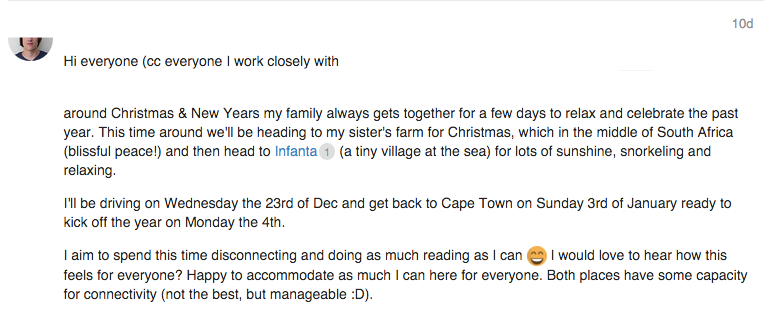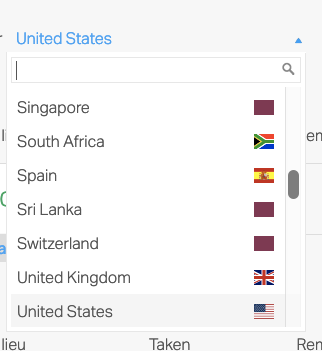When we first started out building Buffer, time off seemed pretty simple.
We offered unlimited vacation time to use as teammates saw fit. And since we were distributed across the world, teammates could simply decide which holidays they cared about and take them off.
Easy, right?
Turns out humans are a bit more complex than that.
Over time, we learned that unlimited vacation policies statistically see employees take less time off, not more. And we discovered that having no set holiday schedule meant that every holiday absence seemed to require a major justification and an offer to work if needed, like this:

Through lots of trial and error, we’ve now gotten to what I believe is a healthy and positive place when it comes to time off. Although it’s not quite as simple as those early days, the outcome for our team health is much better.
Here’s where we’re at today in terms of all kinds of paid time off.
Vacation: Minimum with quarterly check-ins
Vacation is something that has changed a lot at Buffer, from unlimited vacation (underused) to paying our team to take a vacation (not the most sustainable) to our current minimum vacation time for each teammate of three weeks off per year.
Through Buffer’s current flexible time off policy, teammates can take as much or as little time off as they want. There is no annual cap on paid flexible time off. No one needs to worry about whether they have enough time available since no vacation or sick days are earned, accrued, or used under this policy.
Here are the exact guidelines we share with the team:
- We encourage team members to take a minimum of 3 weeks (15 work days) of time off throughout the year.
- There is no maximum time-off recommendation, though there may be more conversation with your lead for unique situations in which a teammate might want to take, say, 6–8 weeks off.
- It’s generally great to begin to take time off after you’ve been at Buffer for about 3 months. (If you’re newer to the team and have something already planned, no worries! We’ll take it case by case).
- This time is in addition to public and religious holidays that you observe.
- Sick time, personal days, and wellness days are included in flexible time 0ff.
- Teammates will receive regular pay for time off.
- Buffer is a global team; please take time off that’s in line with your country’s standards.
Additionally, the People Team keeps an eye on how much vacation time folks are taking off, sharing a quarterly report with team leads to make sure everyone is planning restorative time away.
This mix of specific guidelines, a minimum standard, and some vigilance to make sure folks are remembering to book time away seems to have gotten us to a nice equilibrium with time off.
Holidays: Default holidays off for your country
On a global team, we all celebrate different holidays – which is great! But we wanted to make it easier for teammates to be fully off for the holidays of their region without putting the burden on them to ask for the time or have to justify it.
Our biggest iteration on holidays was to switch from having teammates ask to take them to proactively assigning holidays as default days off by each teammate’s country. We use a tool called Timetastic for time off tracking, and they helpfully have many countries’ holidays pre-loaded into the app (and have an option to create a new listing for any countries they lack).

With this small but significant change, folks now take off the holidays of their region automatically. No need to message anyone, no need to share why the holiday is important or what you’re going to do.
This is of course coupled with our flexible time off policy to make it fully customizable, so for example folks who are living in one country but feel more aligned with the holidays of their home country can certainly take whichever holidays are best for them.
Buffer holidays: Strategically timed “office closures”
In addition to vacation time and each country’s holidays, a new category of time off has emerged more recently at Buffer.
As we grew over the years, we realized that there was no time where everyone on the team stopped working. Great news for customers! But for the team, this can lead to a low-grade but persistent stress, knowing that others are working while you’re away and feeling like a blocker, or knowing that you’ll come back from time away to a lot of missed communication.
To remedy this, we started experimenting with “Buffer is closed” time a few years ago in December and have expanded it since.
We now regularly close Dec. 25-Jan. 1 and this year for the first time, we closed Buffer for a mid-year holiday July 3-5. (Next year we’ll likely do a full week!) Both of these are pretty U.S.-centric times to be closed, so it would be great to expand into some other region’s holidays times too.
Additionally, we’re also trying half-day Fridays throughout the month of August.
So far we’ve discovered that company-wide time off for a global remote team is powerful because there’s no catch-up afterwards!
Tomorrow at @buffer we start our first ever company-wide mid-year break (W-F off) ?
Company-wide time off for global remote teams is powerful: there's no catchup afterwards ?⛔️
Excited about how we're trying to create fulfilling long-term work that doesn't cause burnout ?? https://t.co/7DapkRk5O6
— Joel Gascoigne (@joelgascoigne) July 2, 2019
Sabbaticals: Preventing burnout at 5-year mark
Our most recent addition to the time off stable is the Buffer sabbatical.
After every 5 years of working at Buffer, we’re inviting teammates to take a 6-week break, fully paid.
Sabbatical time (which is totally optional) can be spent however teammates like: Working on a side project, traveling, helping a nonprofit, achieving a life goal, spending time with family or something else altogether. There are no specific requirements for this time – we trust our team to know best what they need!
Right now, we’re recommending a sabbatical time frame of about 6 weeks every 5 years. Plus, every year teammates work at Buffer beyond 5 years without taking a sabbatical will add an extra week of sabbatical time, capped at a 12-week maximum.
We’ll see our first team sabbaticals in just a few months, and we’re excited about trying to create fulfilling long-term work that doesn’t cause burnout.
Other types of leave
There are a few other types of leave that might be interesting to hear just a bit about:
Sick leave: This is included in our general flexible time off policy, so folks can take as much as they need.
Compassionate, caregiver, or bereavement leave: Flexible time as the need arises; generally around 3-5 days but not prescriptive
Disability leave: For up to 4 weeks of leave, a teammate’s pay will be fully covered. Beyond that, we work on a case-by-case basis to transition to short- or long-term disability.
Family leave: 12 weeks recommended for all parents. More on family leave at Buffer.
Wellness/”Unsick Day”: Our “Unsick Day” is a dedicated day off just for preventive care. Teammates are welcome to take a day every year to proactively care for their health through appointments like:
- Annual physical
- Dental cleaning
- Vision exam
- Counseling or therapy
- Well-woman exam
- Skin screening
- Any other preventive care that feels like a good fit!
It’s a great way to keep those “boring self-care” appointments top of mind.
Local Election Day: For any country that has elections during the work day, we ask teammates to consider Election Day a holiday and take the time they need to participate in elections.
Buffer Volunteering: 1 day per quarter to volunteer or serve. More on our volunteer program.
Over to you!
It’s often a fun and unexpected challenge to anticipate the way our highly motivated and conscientious team will use (or not use) our time off policies.
Additionally, as we experiment, we always try to balance our team’s needs with our customers’ needs, since they’re the reason we get to do what we love every day. It’s a delicate balance, and one that we’re always calibrating.
How do you craft time off policies to ensure you get great work done and also have an energized and well-rested team? I’d love to hear about any of your tips or experiments in the comments!
Try Buffer for free
190,000+ creators, small businesses, and marketers use Buffer to grow their audiences every month.




